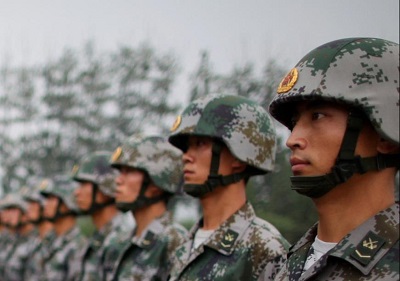Context
China’s recent restructuring of its military, particularly the dissolution of the People’s Liberation Army Strategic Support Force (PLASSF) and the establishment of the Information Support Force (ISF), marks a significant shift in its approach to cyber and space capabilities. This move has profound implications for India, as it widens the technological and strategic gap between the two nations. By examining the reasons behind this restructuring and its potential impact, it becomes evident that India must reassess and bolster its own capabilities to keep pace with China’s evolving military strategies.
Background of PLASSF and its Replacement
In late 2015, China, under President Xi Jinping, created the PLASSF and the People’s Liberation Army Rocket Force (PLARF). The PLASSF was designed to integrate the Chinese military’s space, cyber, electronic, and psychological warfare capabilities into a unified command structure. However, the recent dissolution of the PLASSF and its replacement with the ISF represents a strategic shift aimed at enhancing the efficiency and oversight of these critical domains.
The PLARF, which evolved from the Second Artillery Force (SAF), remains intact, continuing to hold command authority. Alongside these changes, China had also established five Theatre Commands (TCs) in 2015-16 to streamline its military operations. The PLASSF’s replacement with the ISF indicates a move towards a more flexible and responsive command structure, better suited to modern warfare requirements.
Three primary reasons can be identified for the dissolution of the PLASSF. Firstly, there was a need for greater oversight and control by the Central Military Commission (CMC), the top decision-making body led by President Xi Jinping. The strategic importance of the PLASSF required it to be closely monitored to ensure alignment with the broader objectives of the Chinese military and political leadership.
Secondly, the bureaucratic rigidity of the PLASSF posed significant challenges. Theatre Commands often had to seek approval from the PLASSF for resources or assets, leading to delays and inefficiencies. The co-equal command status of the PLASSF with the TCs created obstacles that hindered operational effectiveness. By restructuring, China aims to streamline command and control processes, allowing TCs easier access to necessary resources.
The third reason is informed by the ongoing war between Russia and Ukraine. The conflict has highlighted the necessity of flexibility in deploying cyber, electronic, and space-borne resources. China has observed the importance of adaptable and efficient use of these assets in modern warfare, prompting the reorganization to enhance operational effectiveness.
The creation of the Information Support Force (ISF) is part of a broader restructuring that includes the formation of the People’s Liberation Army Cyberspace Force and Aerospace Force. This brings the total number of PLA forces to four, including the existing People’s Liberation Army Logistics Support Force (PLALSF). The ISF is primarily focused on protecting and defending Chinese networks from external threats, while the Cyberspace and Aerospace Forces handle cyber and space operations, respectively.
This reorganization allows the TCs to access the capabilities and resources of these new forces more efficiently. The ISF’s network information systems and communications support, coupled with potential network defense, ensure a robust defense mechanism against cyber intrusions. The Cyberspace Force and Aerospace Force provide specialized capabilities that can be rapidly deployed to support various military operations.
For India, the restructuring of China’s military capabilities presents significant challenges. The enhanced command and control structure allows China to leverage its cyber, electronic warfare (EW), space, and counterspace capabilities more effectively. This is particularly concerning given China’s substantial investments in these areas, as evidenced by the increased defense budget in 2024 despite economic constraints.
India must be vigilant and prepared to counter the enhanced capabilities of the Chinese military. The fungibility of China’s cyber, EW, space, and counterspace assets means that these resources can be easily redirected to address contingencies along the Sino-Indian border. The Western Theatre Command (WTC), responsible for operations along this boundary, can now access the newly established forces’ resources more readily, posing a direct threat to India’s security.
Strategic Response and Adaptation
The restructuring underscores the importance of flexibility and adaptation in military strategy. India’s military planners need to consider how to deploy and integrate space, cyber, EW, and psychological operations effectively. The separation of cyber warfare and electronic warfare into distinct entities within the Chinese military highlights the need for India to develop and enhance its own capabilities in these domains.
Furthermore, the emphasis on “intelligicised warfare” by the Chinese, which involves the use of artificial intelligence (AI) and automation, presents another area where India needs to focus. AI can significantly augment intelligence collection and cyberwarfare capabilities, making it imperative for India to invest in and develop these technologies to maintain a strategic balance.
Conclusion
China’s dissolution of the PLASSF and the establishment of the ISF, along with the creation of dedicated Cyberspace and Aerospace Forces, represent a strategic shift aimed at enhancing its military’s flexibility and operational effectiveness. This reorganization has significant implications for India, as it widens the gap in cyber and space capabilities between the two nations. India must respond by reassessing its military strategies, investing in advanced technologies, and ensuring that its forces are equipped to counter the enhanced capabilities of the Chinese military. The dynamic nature of modern warfare necessitates continuous adaptation and innovation to maintain a competitive edge.
|
Probable Questions for UPSC Mains Exam 1. Discuss the strategic implications of China's dissolution of the People’s Liberation Army Strategic Support Force (PLASSF) and the establishment of the Information Support Force (ISF) for India's national security. How should India respond to the growing gap in cyber and space capabilities between the two nations?(10 marks, 150 words 2. Analyze the reasons behind China’s military restructuring, particularly the creation of the Cyberspace Force and Aerospace Force, and evaluate its potential impact on regional stability. How can India enhance its own military capabilities to counter these developments effectively?(15 marks, 250 words) |
Source – ORF







